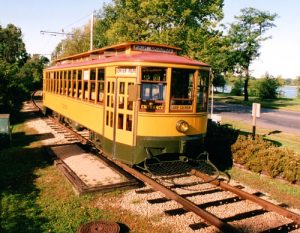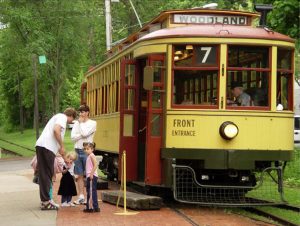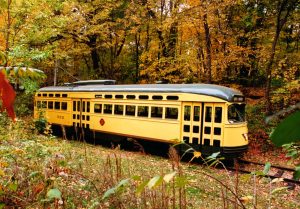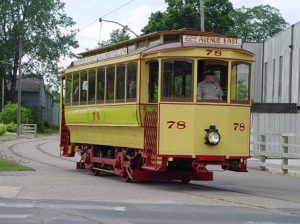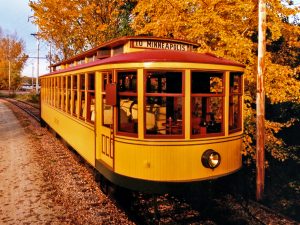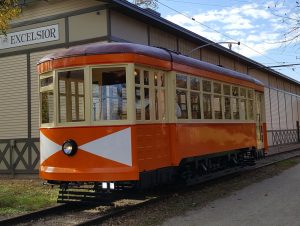The Minnesota Streetcar Museum operates six historic streetcars at it’s demonstration railways in Minneapolis and Excelsior, Minnesota. In addition, the museum owns two additional carbodies.
Twin City Rapid Transit Company No. 1300
Description
Twin City Rapid Transit No. 1300 was part of an order for 19 faster cars to be used on the St. Paul – Minneapolis “interurban” line along University Avenue (See Russ Olson’s history of its various assignments). After the end of streetcar operations in June 1954, it was donated intact to the Minnesota Railfan’s Association, a predecessor of the Museum. Today, this “standard” car appears exactly as it did in the early 1930s. No. 1300 was the first restored streetcar operated on the Como- Harriet Streetcar Line in 1971.
TCRT No. 1300 was built at the company’s Snelling Shops in April 1908, part of class I-1. In December, 1928, No. 1300 was rebuilt with a folding front exit door and triple rear gates. Its class was changed to I-8. In November 1931, it was again rebuilt, this time for one or two man operation with the addition of folding rear doors. Its class was changed to N.
No. 1300 was donated to the Minnesota Railfan’s Association in June, 1954. In September 1954, it was moved by the Milwaukee Road to the Minneapolis-Moline plant in suburban Hopkins for storage. In August, 1962 it was again moved, to the Minnesota Transfer Railway roundhouse in St. Paul. Its first public operation occured on Minnesota Transfer Railway yard tracks in July, 1963. Power was supplied by an engine-generator set towed on a trailer. In August 1971, it was moved to restored trackage at Lake Harriet and operation of the Como-Harriet Streetcar Line began.
As-Built Technical Data
- 2 Baldwin #5 Trucks
- 34″ Steel Wheels
- 4 General Electric 213 Motors with 15:71 gear ratio
- K-37-A Controller
- Total weight 47,800 lbs.
- 9′ 2.5″ wide by 46′ 7.125″ long
- Steel underframe with wooden carbody and canvas roof
- General Electric RB trolley base with 4″ trolley wheel
Rebuild Changes
- Trucks replaced with Twin Cities #9RB
- Traction motors replaced with General Electric 203G and 16:68 gear ratio
- Controller replaced with K-43-F2
- Total weight reduced to 46,140 lbs.
- Length reduced to 46′ 0″
Duluth Street Railway No. 265
Description
Twin City Lines class L-8 streetcar was built at Snelling Shops in December 1915 as their first No. 1791. It was sold to the Duluth Street Railways in May 1916 for use on its Morgan Park extension and renumbered No. 265. In September 1929 it was rebuilt for one-man operation as part of a program to meet rising costs and competition from paved roads and the Model T. In September 1939 it was retired when Duluth’s streetcar system was abandoned and the body sold for use as a cabin at Solon Springs, Wisconsin. The Museum acquired it in April 1973 and moved it to rented space in the Northern Pacific’s Como Shops (today’s Bandana Square) in September 1973, where restoration was begun. In September 1980 it was moved to the Como-Harriet Streetcar Line’s Linden Hills Carbarn, where restoration was completed. Its first operation occurred in July, 1982.
The original trucks under DSR No. 265 came from a Chicago Transit Authority car. They were too stiff for No. 265’s weight. The Museum recently had the good fortune of receiving three pair of trucks from Japan. Made in the United States, they were exported in the 1920’s and used in Osaka. The Japanese kept them in excellent shape and they came to us freshly out of service. The pair of Brill 27-E trucks are similar to those used under TCRT cars before to 1905 and provide a much better ride. No. 265’s former trucks were used to restore TCRT No. 1239.
Today the car operates at the Excelsior Streetcar Line.
As-Built Technical Data
- 2 Twin City #9 Trucks
- 34″ Steel Wheels
- 4 General Electric 200 motors with 15:66 gear ratio
- K-43-F2 Controller
- 9′ 1″ wide by 46′ 8″ long
- Steel underframe with wooden carbody and canvas roof
- General Electric #13 trolley base with 7″ trolley wheel
Rebuild Changes
- Motors changed to General Electric 216
- Weight increased to 49,600 lbs.
Twin City Rapid Transit Company PCC No. 322
Description
In 1944, the TCRT board of directors approved the annual purchase of PCC streetcars to replace the aging but well-maintained wooden fleet. PCC No. 322 is from the initial 1946 order of 40 cars that were delivered by the St. Louis Car Company of St. Louis, Missouri between December 1946 and January 1947. TCRT No. 322 arrived in December 1946 and entered service the following month. In 1951 it was converted from two-man to one-man operation.
A 1949 management change resulted in abandonment of plans to acquire a large PCC fleet to replace the wooden cars. Instead, plans were made to abandon all streetcar service in favor of buses. As streetcar service drew to a close, in October 1953, No. 322 was one of thirty cars sold to Public Service Coordinated Transport of Newark, New Jersey for operation in the Newark City Subway. It became their No. 3. They in turn sold it to the Greater Cleveland RTA in April 1978, where it was also No. 3.
In August 1990, No. 322 was purchased by the Museum for restoration and operation. Work was done at the Metro Transit overhaul base in St. Paul from April 1992 until July 1997, when it was moved to the Como-Harriet Streetcar Line for completion. It returned to service in 2000.
Duluth Street Railway No. 78
Description
Duluth Street Railway No. 78 was one of twenty streetcars delivered by the LaClede Car Company of St. Louis, Missouri in October of 1893. It served Duluth until it was retired and its carbody was given to Mrs. Florence Lee of Duluth on September 11, 1911.
Between 1899 and 1905 it was rebuilt from double-ended operation to single-ended. Also, between 1899-1901 or 1904-1907 the rheostat controller was replaced with a K-2 series-parallel controller.
Museum members located the body near Duluth. In December 1971 it was acquired and moved to a University of Minnesota research facility. In September 1973 it was again moved, this time to the Northern Pacific’s Como Shops (today’s Bandana Square) where the Museum was then doing restoration work. Another move occurred in November 1984, when it was moved to the Como-Harriet Streetcar Line’s Linden Hills Carbarn and Shops for restoration. Because of its deteriorated condition and the amount of new material required, No. 78 could almost be termed a replication instead of a restoration. The body, including the bulkheads, is essentially original material. Both platforms and vestibules are new material. The power truck came from Belgium via the East Troy Electric Railroad Museum. When finished in May 1991, it was the Museum’s third operable streetcar and the oldest operating streetcar in the nation.
In the spring of 1999 DSR No. 78 was moved to the new Excelsior Streetcar Line in time for its grand opening.
As-Built Technical Data
- 1 McGuire Truck with 7′ 6″ wheelbase
- 2 Westinghouse #3 motors
- Rheostat type controller
- Total weight 18,000 lbs.
- 8′ 4″ wide by 32′ 9″ long
- Wood frame and body with canvas roof
Twin City Rapid Transit Company No. 1239
Description
TCRT No. 1239 was built at the 31st Street Shops at Nicollet Avenue and 31st Street in Minneapolis in March of 1907. It was one of 25 H-6 class streetcars built between February and April and was one of the final streetcars built at 31st Street as the Twin City Lines’ streetcar manufacturing moved to the new Snelling Shops at Snelling and University Avenues in St. Paul. The old 31st Street Shops were demolished and replaced by the new Nicollet Station, strictly a carbarn with facilities for routine maintenance and repair. Today, the site is occupied by Metro Transit’s Nicollet Garage.
In 1935, No. 1239 was rebuilt with front and rear double-stream folding doors to permit operation by one or two men, identical to the current configuration of TCRT streetcar No. 1300. It was retired in August 1953 and the body was sold to the Transportation Sales Company for disposition. The body was acquired by the Museum in December 1987 and moved to Jackson Street Roundhouse a year later, where limited restoration work was done. On November 24 and 25, 1998, it was moved to the newly-built Excelsior Carbarn on the Museum’s Excelsior Streetcar Line in west-suburban Excelsior, where it would be restored for operation. No. 1239, in its as-built 1907 appearance and configuration, was dedicated and began operations on the Excelsior Streetcar Line on September 11, 2004.
No. 1239 is currently in the Como-Harriet Line carbarn undergoing a major truck upgrade as well as cosmetic work to bring the car to its 1920s appearance.
As-Built Technical Data
- 2 Baldwin #5 Trucks
- 33″ Cast Wheels
- 4 General Electric 70 Motors with 15:71 gear ratio
- K-28-B Controller
- Total weight 49,000 lbs.
- 9′ 2.5″ wide by 46′ 7.125″ long
- Steel underframe with wooden carbody and canvas roof
- General Electric RB trolley base with 4″ trolley wheel
1935 Rebuild Changes
- Trucks replaced with Twin Cities #5 or #9 trucks
- Motors replaced with General Electric 200 motors (as of January 1937) and 213 motors (as of May 1948)
- Controller Replaced with K-35-JJ
- Total weight decreased to 44,651 lbs.
Mississippi Valley Public Service No. 10
Description
Mississippi Valley Public Service No.10 served the city of Winona, Minnesota from 1913 until 1938. It was part of an order for four cars (Numbers 9 to 12) built by the St. Louis Car Company in 1913 and 1914 (job No. 1012) and delivered in April, 1914. Car No. 10 was placed in service in late May, 1914. Originally the car had hand brakes but in 1916, air brakes were installed. The car operated until the abandonment of streetcar service in 1938 and was the last car to run in Winona. Shortly after abandonment of the Winona lines, the car was sold to a local family who used it as the basis for a cabin-a common fate for streetcar bodies; that was also how our Duluth Street Railway No. 265 was saved. The car is a rare example of a single truck streetcar designed for use by a small city streetcar system such as Winona. During the period 1908 to 1916 (before the advent of the lightweight, single truck Birney-type safety car) small city companies that wished to update their streetcar systems and reduce electricity costs with lighter cars replaced older (and old-looking) heavy wood-body cars (usually built before 1900) with modern, light steel-bodied streetcars such as No. 10.
MVPS No. 10 is unique in that it has a steel frame and exterior surfaces but the interior is all wood. Both the interior and exterior of the car is in surprisingly good condition. What also makes this car a rare find is that as far as is known, there are no other cars like No. 10 in restored and operating condition in a transit museum.
No. 10 was purchased by the Museum in the spring of 1999. Volunteers stripped away the surrounding cottage and it was taken by truck to the Excelsior Carbarn for restoration. On Tuesday, November 29, 2016, No. 10 was powered up and ran under its own power for the first time in 78 years! After some trouble shooting, No. 10 ran well in both directions and made several round trips on the Excelsior Streetcar Line’s main line. Although most of the restoration is now complete, issues were discovered in the car’s motors. Work to repair the problems is ongoing.
Additional Carbodies
Fargo & Moorhead Street Railway No. 28
No. 28 was built by the American Car Company in 1923 with a Brill 79E1 truck. No. 28 was one of 16 Birneys acquired for the small Fargo-Moorhead system. The first 15 (Nos. 12 to 14 and 16 to 27) were built by the Cincinnati Car Company in 1920 with Cincinnati No. 139 trucks. Until space becomes available at the Museum’s Linden Hills or Excelsior carbarns, the body is being stored in a facility in Watertown, MN.
The Museum’s 1976 Electric Railways of Minnesota by Russell Olson has scant information mostly obtained from transit directories of the time. One big question is the color of the cars. The black-and-white photo of Birney No. 16 seems to indicate two-tone paint. But there’s no record that we’ve come across as to what those two tones might be.
This small system served the twin cities of Fargo, North Dakota and Moorhead, Minnesota on the Red River of the North. The first street railway activities in Fargo, the larger of the two cities, were short-lived horsecar lines built in 1879 and 1882. The Fargo and Moorhead Street Railway Company was formed in 1902, began construction and opened in 1904 serving Fargo via the North Side Loop, the South Side Loop, and the Oak Grove line and Moorhead via a line from Fargo to the Moorhead Normal College (now Minnesota State University at Moorhead). The system opened with seven single-truck closed streetcars and a single-truck, double-end, arch-roofed wedge plow – certainly a necessity in these parts. Additional lines were built in Fargo to the State Fairgrounds and the North Dakota Agricultural College (now North Dakota State University). Additional cars were acquired for new lines, including a number of second-hand streetcars bought from the Twin City Rapid Transit Company as it replaced its first generation with the TCRT standard streetcar, three versions of which are in the Museum’s collection. By 1912, the system was at its zenith except for a short 1923 extension to Concordia College in Moorhead when the system reached its peak mileage of 15.81 miles. From 1923 to 1925, the system employed 29 motor cars, 16 trailers, 4 service motor cars, and 2 service trailers. But by 1933, the system was all-Birney except for one passenger trailer and the work fleet.
In 1916, Northern States Power, now Xcel Energy, the Minneapolis-based power company, acquired the Consumers Power Company and, with it, its streetcar line. The 16-car Birney fleet, including No. 28, was part of NSP’s modernization of the line. In addition to the usual duties of a small-town trolley, the F&M StRy served North Dakota State University and the North Dakota State Fairgrounds in Fargo and Concordia College and Moorhead State University in Moorhead. The system shut down in stages in 1937 – the Moorhead local lines closed on June 30, the “interurban” line from Fargo to Dilworth, Minnesota (home of a major Northern Pacific facility) on July 2, and the last Fargo line, the South Side Loop, on August 21.
The Museum has no immediate plans for the restoration or use of No. 28. Ahead of it on the restoration agenda are continuing work on 1908-built Twin City Rapid Transit Company No. 1300, the Museum’s “mother car” and a stalwart at the Como-Harriet Streetcar Line, and the restoration of 1913 Saint Louis-built lightweight single trucker No. 10 from the Winona, Minnesota, streetcar system to reduce power consumption on quieter weeknights and in the fall on the Como-Harriet line.
Mesaba Railway No. 10
Description
The Mesaba Railway Company operated interurbans between Hibbing and Gilbert, Minnesota from 1912 until 1927. No. 10 was one of five identical cars ordered from the Niles Car & Mfg. Co. in 1912. It arrived in September, 1912.
At the end of operations in 1927, No. 10’s trucks and motors were sold for scrap to the Duluth Iron and Metal Company and the carbody was sold.
Located at the Excelsior Carbarn, Mesaba No. 10 has not been restored. Until now, a major obstacle has been the general scarcity of electrical and mechanical components for these old wooden carbodies. The Museum had the good fortune of receiving three pairs of trucks from Japan. Made in the United States, they were exported in the 1920’s and used in Osaka, Japan. Among them are a pair of Baldwin 75’s– No. 10 had Baldwin 78’s. They have been installed and the car can now be moved. Cosmetic restoration is just beginning.
Materials
The streetcar’s frame is made of composite wood and steel. The body is made of yellow pine reinforced with I beams and steel plates. The sides and ends are plated with steel and canvas covers the roof.
As-Built Technical Data
- 2 Baldwin 78-22-A Trucks
- 36″ Cold-rolled Steel Wheels
- 4 General Electric 201H Motors
- K-35-G Controller
- Total weight 48,400 lbs.
- 9′ 4″ Wide by 49′ 0″ Long
- U.S. #13 trolley base with 6″ trolley wheel
